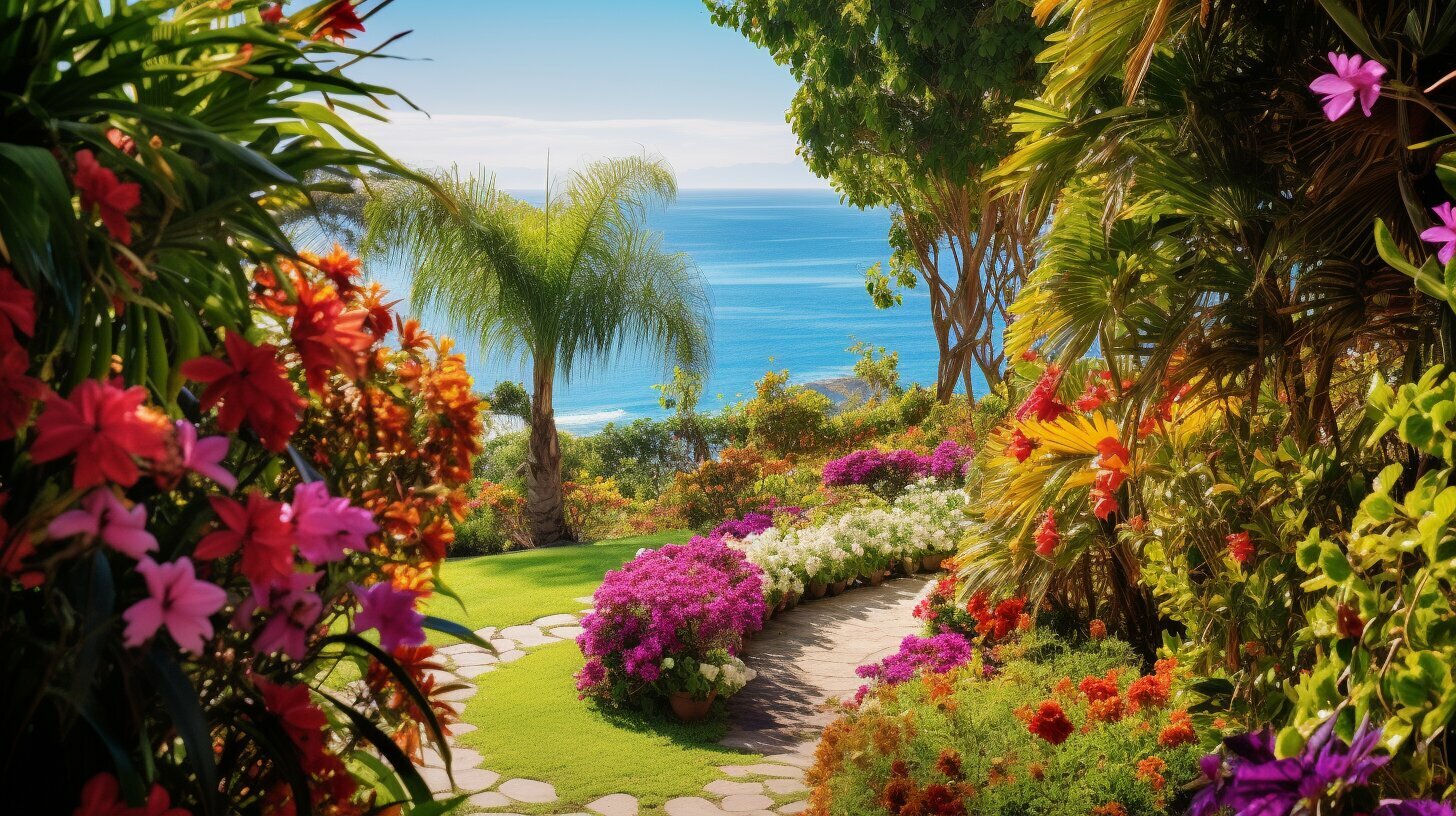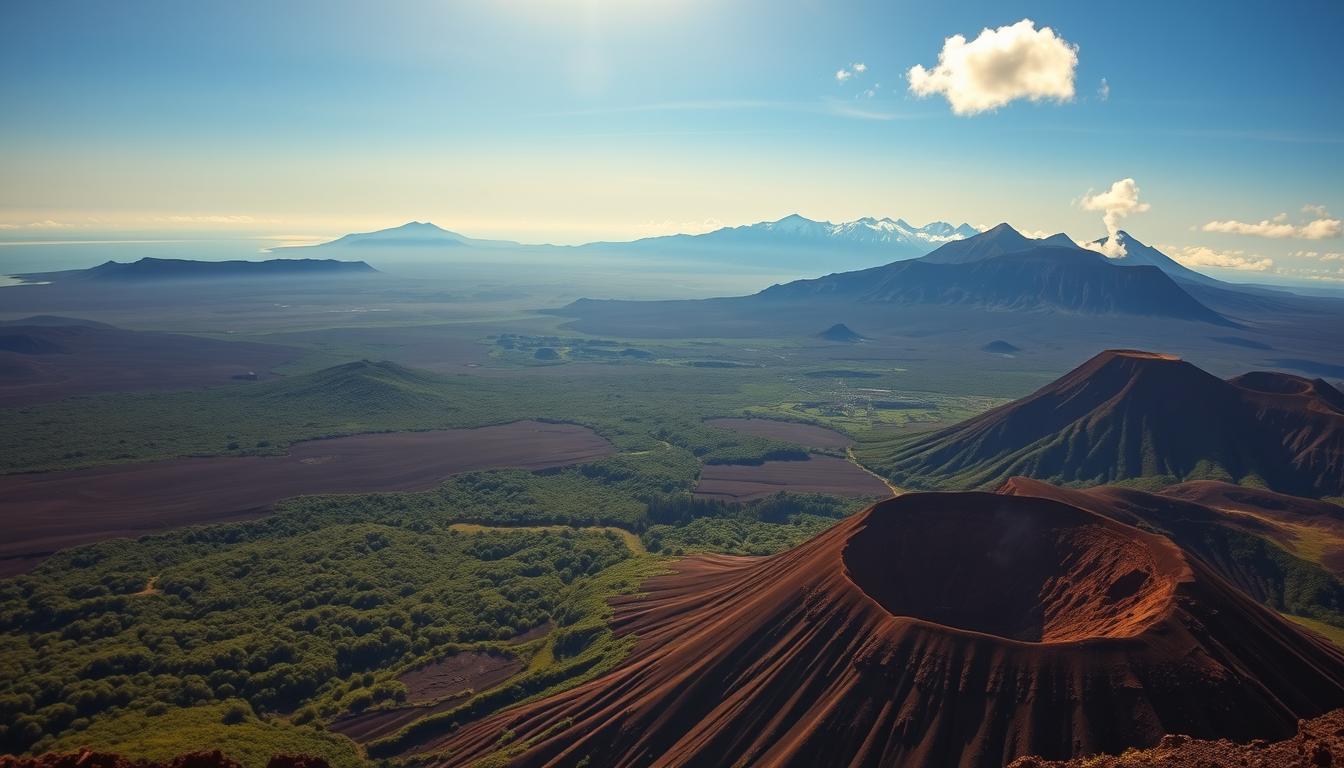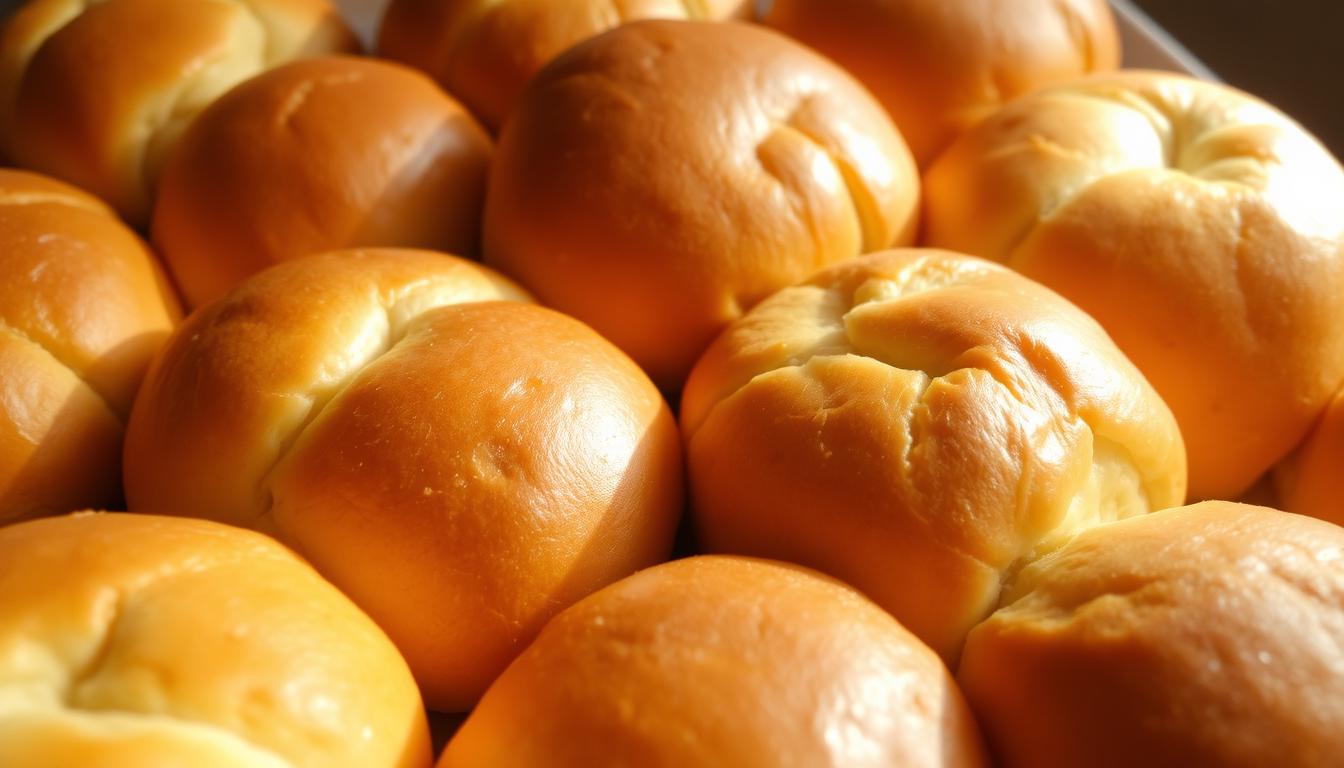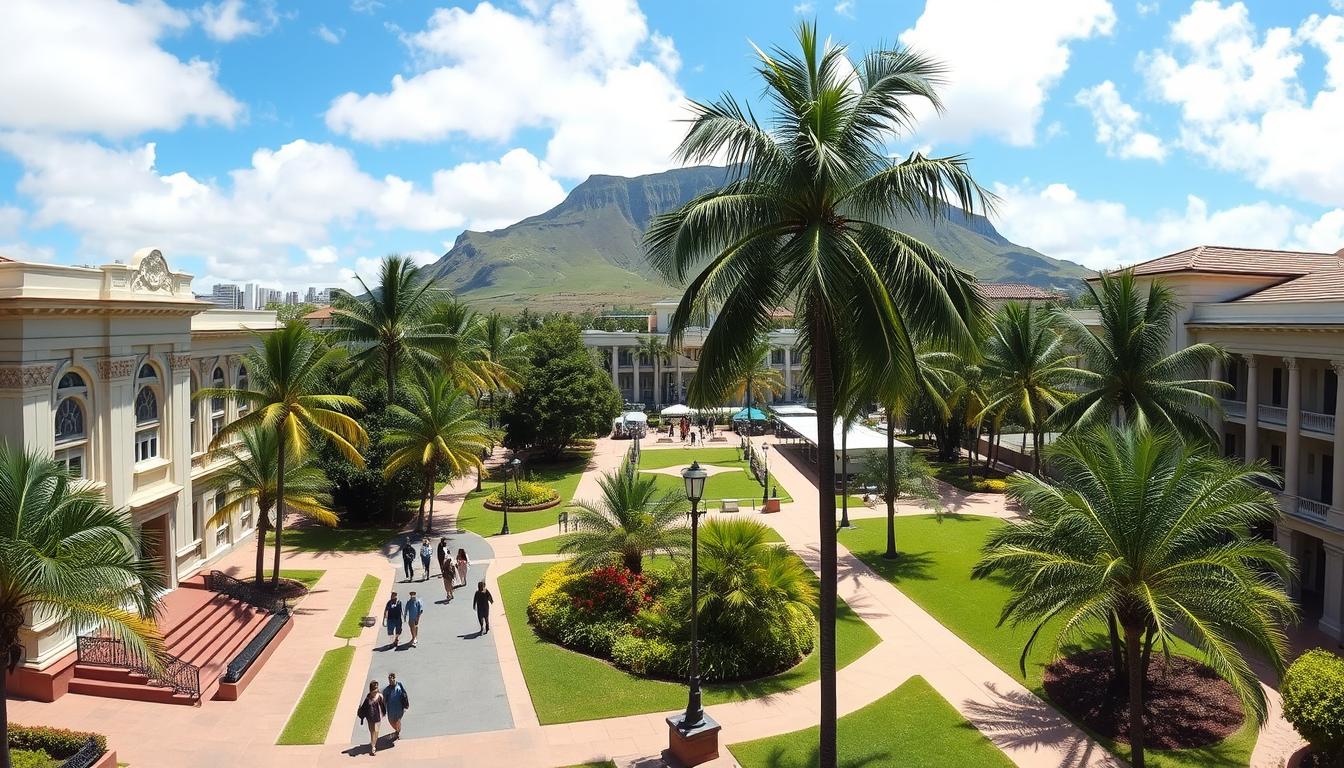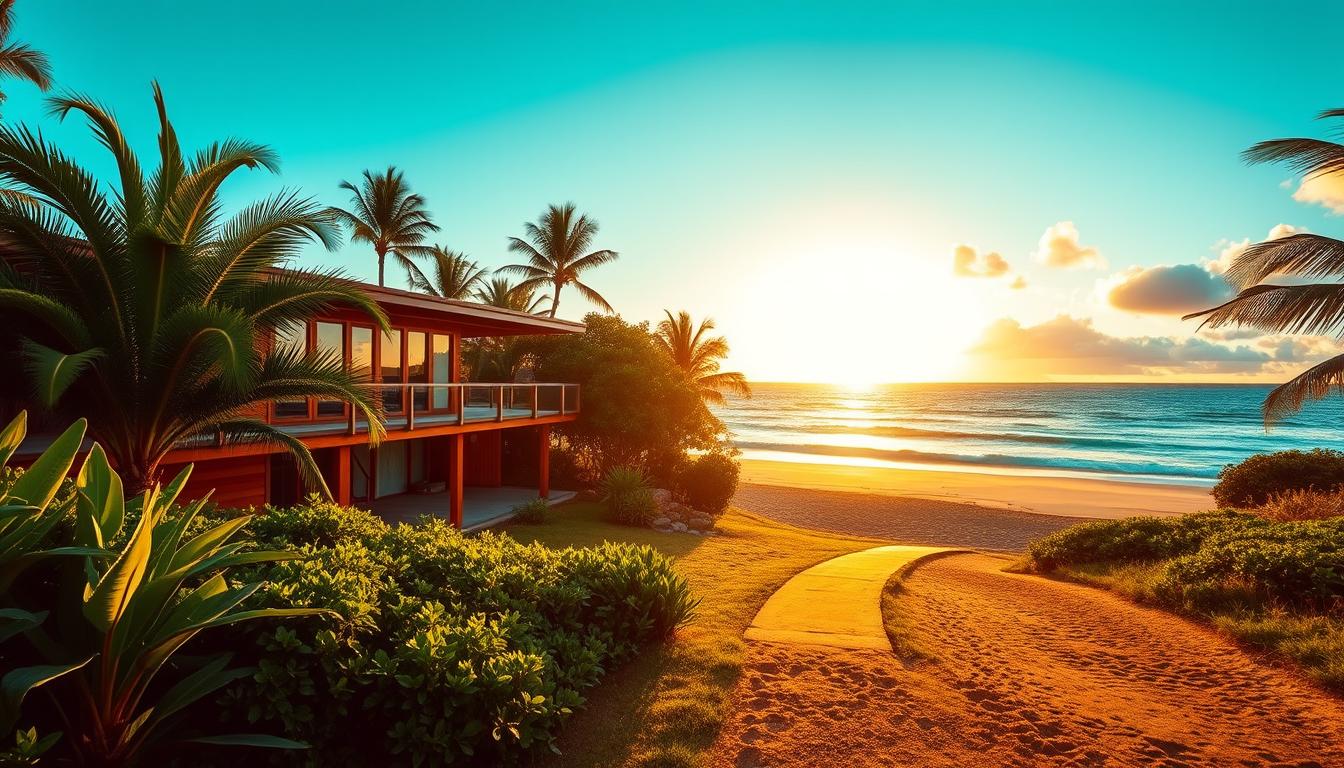Hilo, Hawaii is a paradise for those looking to immerse themselves in nature, indulge in delicious local offerings, and explore the rich cultural heritage of the island. With its stunning waterfalls, vibrant downtown, beautiful parks, and unique attractions, Hilo has something to offer every visitor. Whether you’re seeking adventure, relaxation, or a combination of both, Hilo is sure to exceed your expectations. Here are 17 things you must do during your stay in Hilo, Hawaii.
Key Takeaways:
- Explore the mesmerizing waterfalls of Akaka Falls State Park and Rainbow Falls.
- Discover the charm of downtown Hilo through its unique shops and cultural attractions.
- Indulge in the abundance of fresh produce and unique finds at the Hilo Farmers Market.
- Escape to the serene Japanese oasis of Liliʻuokalani Park and Gardens.
- Uncover the natural disasters and resilience of the island at the Pacific Tsunami Museum.
17 Unique Reasons to Visit Hilo
Hilo, on the Big Island of Hawaii, is a destination with a rich variety of attractions, natural beauty, and cultural significance. Here are 17 reasons to consider visiting Hilo:
Rainbow Falls
Rainbow Falls, or “Waiānuenue,” in Hilo is a compelling spectacle of nature, where an 80-foot cascade creates a mist that, on sunny mornings, produces vivid rainbows, seemingly at the waterfall’s base. This accessibility of this stunning feature is remarkable—no strenuous hike is needed, as the falls are viewable from a nearby parking lot and a well-placed viewing platform. The falls are not only a visual feast but also rich in cultural lore, believed to be the home of Hina, the moon goddess, in Hawaiian mythology. The best rainbows are typically seen before 10 AM when the angle of the sunlight is just right. Encircled by lush tropical flora and grand banyan trees, Rainbow Falls offers a serene experience, capturing the essence of Hawaii’s natural beauty and mythological charm, making it a quintessential stop for any Hilo visitor.
Hawaii Volcanoes National Park
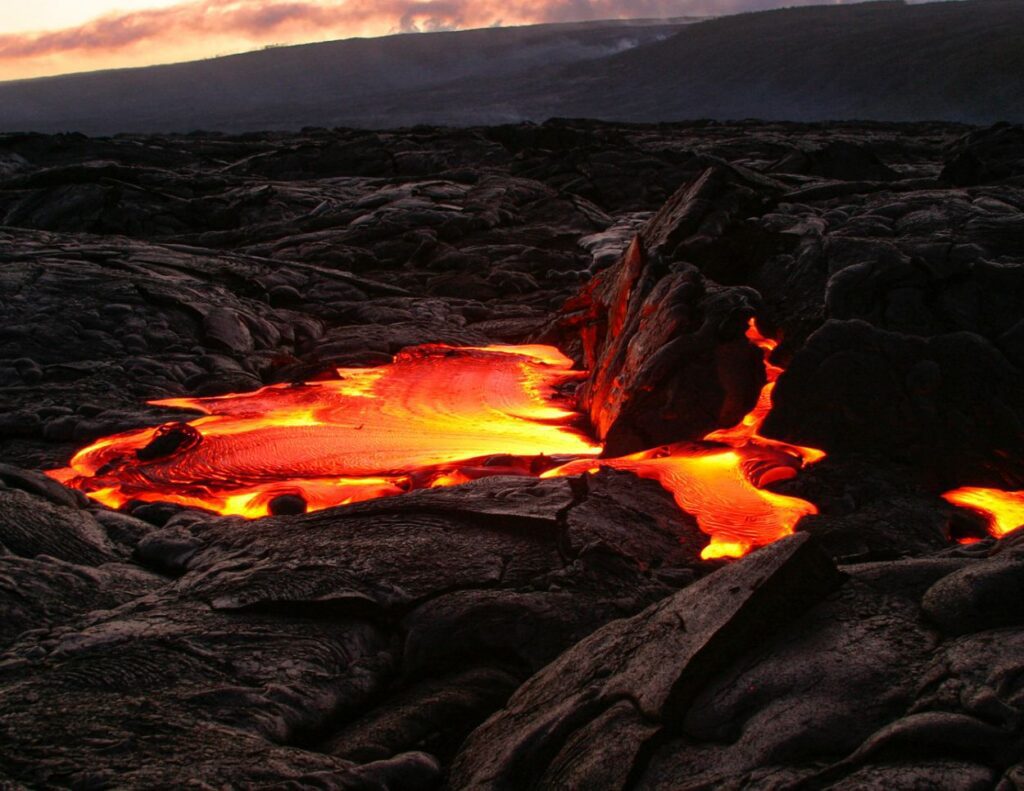
Hawaii Volcanoes National Park is a mesmerizing showcase of nature’s power, featuring two of the world’s most active volcanoes, Kīlauea and Mauna Loa. Visitors can witness the primal process of creation and destruction in this UNESCO World Heritage Site, which offers an array of dramatic volcanic landscapes and ongoing eruptions that reshape the land. The park provides a network of trails and drives that allow exploration of craters, lava tubes, and vast lava fields. The park’s diverse ecosystems and unique geological features offer opportunities for hiking, sightseeing, and cultural education at the Thomas A. Jaggar Museum and the Kīlauea Visitor Center. The chance to observe active lava flows and the glow of volcanic craters at night makes for an unforgettable experience, connecting visitors with the raw power of Earth’s geology. This park is not just an attraction but an ongoing natural event, a place where visitors can safely witness the Earth’s inner forces at work in a dynamic and ever-changing landscape.
Liliuokalani Gardens
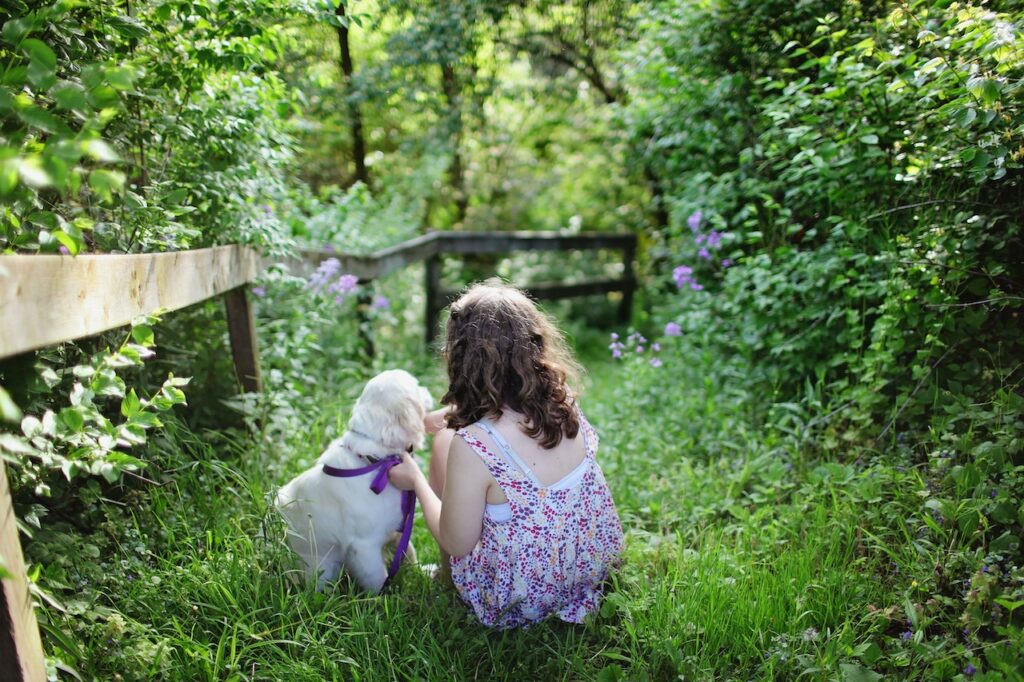
Liliuokalani Gardens in Hilo is a serene escape that celebrates the bond between Japan and Hawaii, named after Queen Liliuokalani, the last reigning monarch of the Hawaiian Kingdom. This beautifully manicured Japanese-style garden stretches over 30 acres and features classic elements such as arched bridges, koi ponds, pagodas, and stone lanterns, all set against the backdrop of Hilo’s bayside views. Tranquil pathways weave through the gardens, inviting leisurely strolls amidst the lush tropical plants and the soothing sounds of water. It’s a perfect spot for picnics, photography, and quiet reflection. The gardens not only offer a peaceful retreat but also serve as a cultural bridge, reflecting the Queen’s appreciation for the Japanese immigrants who came to work in Hawaii’s sugar cane fields. With the majestic Mauna Kea in the distance, Liliuokalani Gardens provides a harmonious blend of natural beauty and cultural harmony, a must-visit for those seeking a moment of peace and a touch of international history in Hawaii.
Mauna Kea Summit
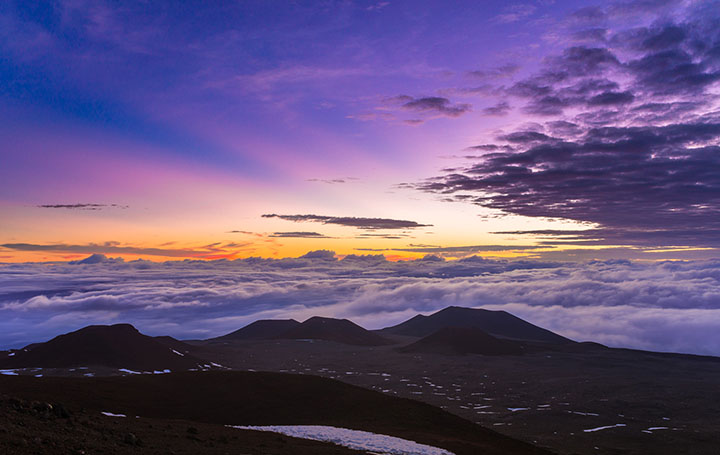
The summit of Mauna Kea, a dormant volcano on the Big Island of Hawaii, offers a truly otherworldly experience. Standing at nearly 14,000 feet above sea level, it’s the highest point in the state and home to one of the most significant astronomical observatories in the world, due to the clear and dark skies above. The journey to the summit takes you through several climate zones, from tropical to alpine, and offers a stark, lunar-like landscape at the top. Mauna Kea’s summit is sacred in Hawaiian culture, believed to be the meeting place of earth and sky. For visitors, it presents a unique opportunity for stargazing and witnessing the breathtaking sunset above the clouds. The contrast of the snow-capped peaks during winter months against the tropical beaches below is a testament to the island’s dramatic diversity. However, the high altitude requires visitors to acclimatize at the visitor’s center before ascending, ensuring a safe and unforgettable experience in this majestic place where science and spirituality converge.
Imiloa Astronomy Center
The Imiloa Astronomy Center in Hilo is a unique facility where Hawaiian culture intersects with the cutting-edge science of astronomy. Nestled on the slopes of Mauna Loa, the center is part of the University of Hawaii at Hilo campus and presents a futuristic dome-shaped structure that houses a planetarium, interactive exhibits, and educational programs. Visitors can delve into the mysteries of the universe, exploring exhibits that explain the formation of stars and planets, and learn about the significant discoveries made from the nearby Mauna Kea observatories. The center also provides a rich cultural perspective, highlighting the navigational prowess of the ancient Polynesians who used the stars to voyage across the Pacific. Imiloa—which means “exploring new knowledge”—is aptly named, as it offers a place for learning and inspiration, bridging the gap between ancient traditions and modern science.
Akaka Falls State Park
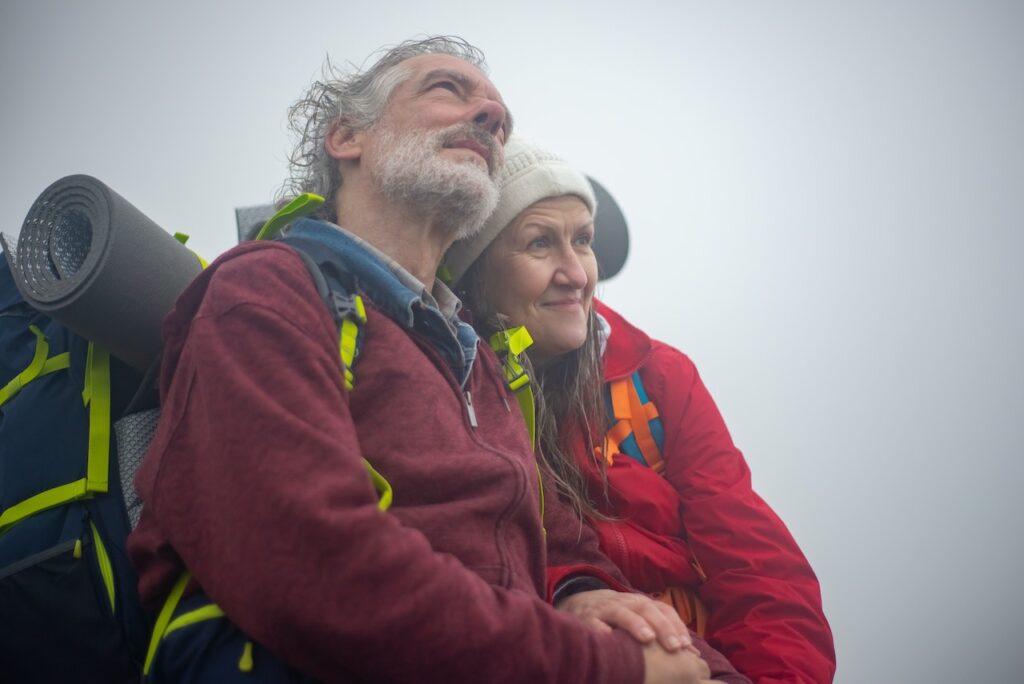
Akaka Falls State Park is a jewel of the Big Island, offering a lush, tropical sanctuary leading to the majestic Akaka Falls. With a plunge of 442 feet, it is one of Hawaii’s most famous waterfalls. The park features a well-maintained loop trail that takes visitors through a verdant rainforest, brimming with wild orchids, bamboo groves, and draping ferns. The short hike, suitable for most fitness levels, culminates in a dramatic view of the waterfall as it cascades into a stream-eroded gorge. The sound of water and the cool, moist air create a refreshing atmosphere that contrasts with the island’s coastal regions. Akaka Falls State Park is not only a feast for the eyes but also a haven for native birds, making it a popular spot for birdwatchers. The easy accessibility and the powerful beauty of the waterfall make it a must-visit for nature lovers and those seeking a tranquil retreat into Hawaii’s tropical bounty.
Hilo Farmers Market
The Hilo Farmers Market is a vibrant hub of the Big Island’s fresh produce and local crafts, reflecting the rich tapestry of Hilo’s community and the abundance of Hawaii’s agriculture. Open daily with over 200 local farmers and crafters, it becomes even more extensive on Wednesdays and Saturdays, offering an array of exotic fruits, vegetables, flowers, homemade delicacies, and unique artisanal goods. This open-air market is not just a place to shop; it’s a sensory experience where visitors can taste tropical fruits like rambutan or lychee, savor freshly prepared foods, and interact with local farmers and artisans. The sounds of live music often fill the air, adding a festive note to the colorful stalls and friendly chatter. The Hilo Farmers Market is a lively gathering place where tourists can immerse themselves in local culture, pick up handcrafted souvenirs, and indulge in the freshest farm-to-table experiences, making it a cornerstone of the Hilo community and a delightful stop for those exploring the island.
Richardson Ocean Park
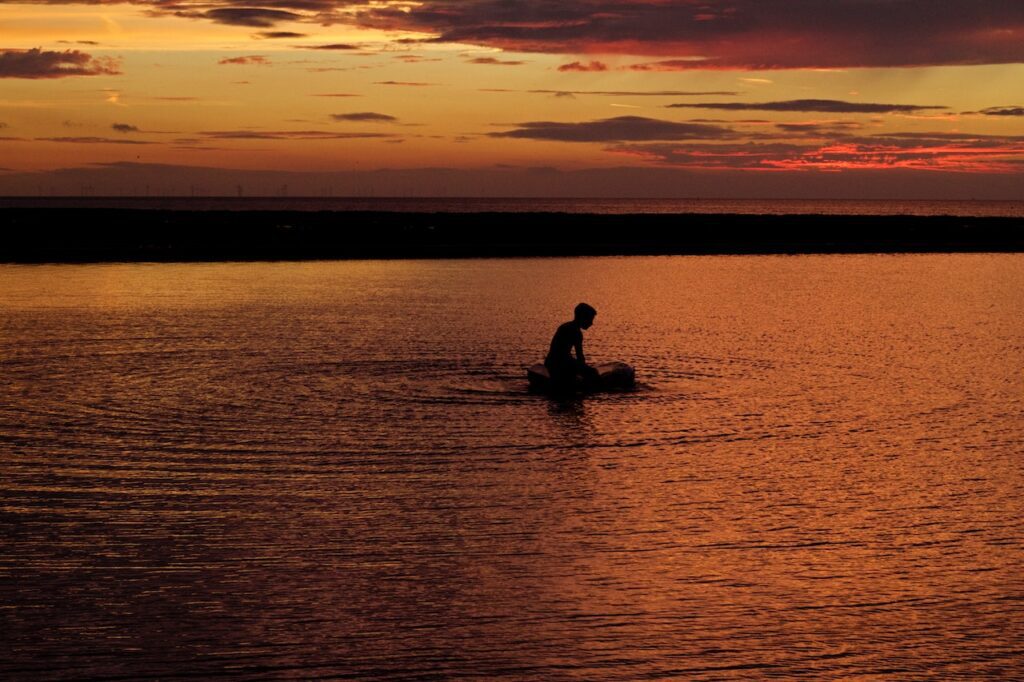
Richardson Ocean Park is a unique coastal gem in Hilo, renowned for its black sand beach and the chance to observe Hawaiian green sea turtles, known as “honu,” in their natural habitat. This family-friendly park combines the allure of tropical marine life with the comforts of picnic areas and facilities, making it an ideal spot for a day at the beach with the added bonus of educational opportunities. The black sand, created by volcanic lava, contrasts strikingly with the blue Pacific waters and provides a distinctive sunbathing experience. The park’s natural lava rock pools are filled with clear water, allowing for safe snorkeling and the chance to explore the vibrant underwater world of coral and tropical fish. The park is also a great place for learning, as informative signs describe the ecological significance of the area and the life cycles of the turtles that frequent its shores. With its serene atmosphere, unique geological features, and the opportunity to witness endangered species in the wild, Richardson Ocean Park is a peaceful retreat that offers a deeper connection with Hawaii’s diverse marine ecosystems.
Pacific Tsunami Museum
The Pacific Tsunami Museum in Hilo serves as a poignant reminder of the power of nature and the resilience of the people of Hawaii. Situated in an area that has experienced some of the most devastating tsunamis in the Pacific, the museum provides educational exhibits that recount the history and impact of these events through survivor testimonies, photographs, and interactive displays. It’s not just a museum; it’s a memorial and an educational center that emphasizes the importance of tsunami preparedness. Visitors gain insights into the science behind tsunamis, the warning systems in place, and the steps to take for safety. The stories of past tsunamis, including the tragic events of 1946 and 1960 which significantly affected Hilo, are told with sensitivity and a focus on community strength and recovery. The Pacific Tsunami Museum is an essential visit for those looking to understand the dynamic nature of the Hawaiian Islands and the measures taken to protect its inhabitants, making it an informative and emotionally resonant experience.
Merrie Monarch Festival
The Merrie Monarch Festival in Hilo is the pinnacle of hula culture, a week-long celebration held annually after Easter that honors King David Kalākaua, known as the “Merrie Monarch” for his role in reviving Hawaiian traditions, arts, and language. This prestigious event draws hula halau (schools) from across the globe to compete in what is often referred to as the “Olympics of hula.” The festival’s competitions are broadcasted internationally, showcasing the ancient (kahiko) and modern (‘auana) forms of hula, along with the intricate craftsmanship of costumes and the haunting beauty of oli (chants). Beyond the competition, the festival encompasses a series of cultural events, including music, art fairs, and parades, providing an immersive Hawaiian cultural experience. It’s a vibrant testament to Hawaiian heritage, where the aloha spirit is palpable, and the rhythmic dance and music fill the air, making it a must-see for anyone interested in experiencing the heart and soul of Hawaii’s rich traditions.
Panaewa Rainforest Zoo
The Panaewa Rainforest Zoo, nestled amidst the lush foliage of a tropical rainforest near Hilo, is the only natural tropical rainforest zoo in the United States. This unique zoo offers visitors the chance to see a variety of animals, including the endangered Hawaiian nēnē goose, colorful peacocks, and even a royal Bengal tiger, set against a backdrop of exotic flora and fauna that thrive in Hawaii’s rich environment. The zoo’s layout meanders through a dense canopy of rainforest trees, with interactive exhibits that educate visitors about the importance of conservation and the roles these species play in the world’s ecosystems. With its free admission, the zoo is a family-friendly destination that invites exploration and discovery, offering a close-up experience with animals and the diverse plant life of Hawaii. The Panaewa Rainforest Zoo is more than just an animal sanctuary; it’s a living, breathing slice of the island’s natural beauty, providing a serene and educational day out for anyone interested in wildlife and the environment.
Hilo Art Museums
Hilo’s art museums are cultural havens that capture the creative spirit of the Big Island, showcasing a blend of traditional Hawaiian art, contemporary works, and multicultural influences. These museums, such as the East Hawaii Cultural Center, offer a window into the island’s soul, featuring exhibitions from local artists that range from vibrant paintings and sculptures to intricate crafts and multimedia installations. Visitors can engage with the art through gallery walks, workshops, and live performances, often accompanied by the artists themselves sharing their insights and inspirations. The art displayed not only reflects the stunning natural beauty and rich history of Hawaii but also addresses broader themes of identity, community, and global interconnectedness. These intimate venues provide a respite from the bustling tourist spots, allowing for thoughtful contemplation and a deeper appreciation of the island’s diverse artistic heritage. Hilo’s art museums are essential destinations for culture enthusiasts and anyone looking to connect with the local art scene and the community’s pulse.
Hilo Botanical Gardens
The Hawaiian Tropical Botanical Garden near Hilo is a living museum, a 40-acre valley sanctuary that showcases the extraordinary diversity of Hawaii’s tropical flora. With over 2,000 species, this botanical garden is a paradise for plant lovers and conservationists, featuring an extensive collection of native Hawaiian plants, as well as exotic species from around the world. Winding paths take visitors through rainforest groves, past cascading waterfalls, and along the rugged Pacific coastline, offering a sensory feast of colors, fragrances, and sounds. The garden is not just about beauty; it is a place of preservation and education, where each plant is carefully tended to protect rare species and to serve as a genetic bank. The boardwalks and trails are designed to create an immersive experience, giving visitors the feeling of stepping into an untouched tropical rainforest. The Hawaiian Tropical Botanical Garden is a tranquil retreat that provides an opportunity to connect with nature and learn about the delicate ecosystems of Hawaii, making it a must-visit for those who seek to experience the lush abundance and tranquility of the island’s natural world.
Lyman Museum and Mission House
The Lyman Museum and Mission House in Hilo offers a unique journey through the natural and cultural history of Hawaii. The museum, originally established as a family mission house in 1838, has evolved into a comprehensive showcase of Hawaiian heritage, featuring extensive collections of artifacts, fine art, and natural history exhibits. Visitors can explore two main sections: the Earth Heritage Gallery, which delves into the fascinating volcanic geology of the islands, and the Island Heritage Gallery, which displays the diverse cultural influences that have shaped Hawaii’s communities. The adjacent original Lyman Mission House, the oldest standing wood structure on the Big Island, has been meticulously preserved to reflect the life of early Christian missionaries and their interactions with the Hawaiian people. Through docent-led tours, guests can step back in time to experience the daily life of the 19th century, providing a poignant glimpse into the past. The Lyman Museum and Mission House not only preserves the Lyman family’s legacy but also serves as an educational resource that bridges Hawaii’s history with its present, making it a valuable and enlightening destination for history buffs and curious travelers alike.
Onomea Bay
Onomea Bay, just north of Hilo on the Big Island’s lush Hamakua Coast, is a hidden gem of natural splendor. This picturesque bay, carved by the relentless force of the Pacific, is accessible via the scenic 4-mile Pepeekeo Point drive, which offers stunning coastal views and a sense of serene isolation. The bay itself, with its dramatic cliffs and vibrant greenery, can be viewed from the road, or visitors can take the short but steep Onomea Trail to the water’s edge. This peaceful stroll through a tropical botanical garden reveals a myriad of plant species, small streams, and eventually leads to the tranquil bay, where the sound of waves and calling of seabirds provide a tranquil soundtrack. Not typically crowded, Onomea Bay is a sanctuary for those seeking a moment of reflection or a romantic walk, away from the buzz of tourist hotspots. Its unspoiled beauty and the soothing presence of nature make Onomea Bay a must-visit for travelers looking to connect with the quiet majesty of Hawaii’s landscape.
Hamakua Coast
The Hamakua Coast, stretching along the northeastern shore of the Big Island from Hilo to the Waipio Valley, is a breathtaking panorama of rugged cliffs, lush valleys, and cascading waterfalls. This historic area, once the heartland of the sugar industry, is now a drive through a verdant landscape dotted with quaint towns and remnants of old plantations. The drive itself is an attraction, with each turn revealing expansive ocean views and lush tropical foliage. Visitors can stop at various points of interest, including the Waipio Valley Lookout, which offers vistas of steep valley walls and taro fields, and the charming town of Honokaa with its plantation-era architecture. The Hamakua Heritage Corridor also features numerous trails leading to hidden waterfalls and scenic overlooks, inviting adventurous travelers to explore on foot. The region’s rich soil supports a thriving agriculture community, and local farm tours provide a taste of fresh Hawaiian produce. The Hamakua Coast is more than just a scenic drive; it’s a journey through Hawaii’s sugar cane past, a celebration of its natural beauty, and an invitation to explore the island’s rural charm.
Seasonal Whale Watching
Seasonal whale watching in Hilo is an exhilarating experience, offering visitors the chance to witness the majestic humpback whales that migrate to the warm Hawaiian waters annually from December to April. These magnificent creatures travel thousands of miles from the cold waters of Alaska to breed, give birth, and nurture their young in the relative safety of Hawaii’s seas. During the season, the ocean around Hilo comes alive with these gentle giants, and their awe-inspiring breaches and tail slaps can often be seen from the shore. For a closer encounter, various tours take spectators out to sea, where the experience of seeing a humpback whale up close is nothing short of magical. The sight of a mother whale with her calf or a pod gracefully navigating the ocean deep is an unforgettable spectacle and serves as a powerful reminder of the ocean’s ecological significance. Whale watching in Hilo not only provides a thrilling adventure but also an educational one, as many tours are guided by marine biologists who offer insights into the lives and habits of these incredible cetaceans, making it a must-do for wildlife enthusiasts and nature lovers visiting Hawaii.
Recommended Exhibits and Events:
- Visit the Hilo Art Museum’s featured exhibit, showcasing the works of renowned local artists.
- Attend a live hula performance at the Merrie Monarch Festival’s hula competition.
- Explore the galleries in downtown Hilo, such as the Palace Art Center, which features a variety of local and international artists.
- Participate in a traditional craft workshop, where you can learn the art of lei making, lauhala weaving, or ukulele playing.
“Art enables us to find ourselves and lose ourselves at the same time.” – Thomas Merton
By immersing yourself in the art and culture of Hilo, you’ll gain a deeper understanding of the island’s heritage and connect with the creative energy that flows through its people. Whether you’re admiring a masterpiece at the Hilo Art Museum, mesmerized by the grace and passion of hula dancers at the Merrie Monarch Festival, or browsing the local galleries in search of your own artistic treasure, Hilo offers a rich and inspiring experience for art enthusiasts of all kinds.
| Attraction | Address | Opening Hours |
|---|---|---|
| Hilo Art Museum | 141 Kalakaua St, Hilo, HI 96720 | Tuesday-Sunday: 10am-4pm |
| Merrie Monarch Festival | Hilo, HI 96720 | Annual Event in April |
| Palace Art Center | 23 Rainbow Dr, Hilo, HI 96720 | Monday-Friday: 9am-4pm |
Volcano Day Trips from Hilo and Hilo Historic Sites
Embark on a thrilling adventure with volcano day trips from Hilo, where you can witness the raw power of nature and discover the rich history embedded in Hilo’s historic sites. Hilo, located on the eastern side of the Big Island of Hawaii, offers a gateway to the mesmerizing volcanoes that define the island’s landscape. One of the must-visit destinations is Volcanoes National Park, home to the active Kilauea volcano. Here, you can explore the vast craters, hike through volcanic landscapes, and witness the fiery lava flows up close. It’s a truly awe-inspiring experience that allows you to witness the ongoing geological processes that have shaped the island.
In addition to the volcanic adventures, Hilo is also rich in history, with several historic sites worth exploring. The Hilo Heritage Museum provides a glimpse into the area’s past, showcasing artifacts and exhibits that tell the story of the town’s development. The Lyman Museum and Mission House is another fascinating attraction, offering insight into Hawaii’s natural and cultural history through interactive exhibits and displays. For those interested in the history of the sugar industry, a visit to the Hawaiian Plantation Museum is a must. Located in a beautifully restored plantation house, the museum showcases the hardships and achievements of the sugar workers who shaped the region.
To further immerse yourself in Hilo’s vibrant past, take a stroll along Banyan Drive, known as the “Hilo Walk of Fame.” Here, you’ll find dozens of banyan trees planted by notable figures who have visited Hilo, including Amelia Earhart and Babe Ruth. Each tree is marked with a plaque sharing the story of the person it was dedicated to, providing a unique glimpse into Hilo’s historical connections.
Table: Hilo Historic Sites
| Historic Site | Description |
|---|---|
| Volcanoes National Park | Explore active volcanoes and witness lava flows. |
| Hilo Heritage Museum | Discover the history of Hilo through exhibits and artifacts. |
| Lyman Museum and Mission House | Learn about Hawaiian natural and cultural history. |
| Hawaiian Plantation Museum | Explore the history of the sugar industry in Hilo. |
| Banyan Drive | Take a walk among banyan trees planted by famous visitors. |
Whether you choose to explore the volcanic wonders or delve into Hilo’s rich history, volcano day trips and historic site visits in Hilo are sure to leave you with a deep appreciation for the island’s natural beauty and cultural heritage. So, pack your sense of adventure, and get ready to discover the captivating allure of Hilo, Hawaii.
Conclusion
Hilo, Hawaii, beckons with its diverse range of attractions and activities, inviting visitors to immerse themselves in a world of natural wonders, cultural discoveries, and unforgettable adventures. From the breathtaking Akaka Falls State Park and the mesmerizing Rainbow Falls to the exploration of underground lava tubes in Kaumana Caves State Park, Hilo offers an abundance of opportunities to connect with nature and witness its awe-inspiring beauty.
For those seeking relaxation and island hopping, Coconut Island provides a pristine escape with its palm tree-lined shores, while the Hamakua Coast Scenic Drive offers panoramic views of canyons, waterfalls, and black sandy beaches, making it a sightseeing paradise.
Imiloa Astronomy Center combines the exploration of celestial wonders with Hawaiian culture and history, providing a unique and enriching experience. Liliuokalani Gardens, nestled near Coconut Island, offers a serene Japanese garden experience, perfect for those seeking tranquility amidst natural beauty.
For beach lovers, Richardson Ocean Park boasts sparkling black sand and ideal snorkeling conditions, while Carlsmith Beach Park offers a one-of-a-kind beach experience with its sprawling lawn, volcanic rock formations, and tranquil blue-green waters.
No visit to Hilo is complete without a trip to the Hilo Farmers Market, where visitors can indulge in fresh local produce and browse through a variety of vendors offering unique crafts and products. And for an educational and delicious experience, a tour of the Mauna Loa Macadamia Nut Farm is a must, providing insight into the growing and production process of these delectable nuts.
Hilo, Hawaii truly encapsulates the essence of paradise, with its blend of natural beauty, cultural attractions, and mouthwatering local offerings. Whether you’re seeking adventure, relaxation, or cultural experiences, Hilo offers it all. It’s time to pack your bags and embark on an unforgettable journey to this tropical haven.
FAQ
Q: What are some of the top attractions in Hilo, Hawaii?
A: Some of the top attractions in Hilo, Hawaii include Akaka Falls State Park, Rainbow Falls, Kaumana Caves State Park, Coconut Island, the Hamakua Coast Scenic Drive, Wailuku River State Park, Imiloa Astronomy Center, Liliuokalani Gardens, Richardson Ocean Park, the Hilo Farmers Market, Carlsmith Beach Park, and the Mauna Loa Macadamia Nut Farm.
Q: What can I expect to see at Akaka Falls State Park?
A: Akaka Falls State Park offers lush rainforests to explore and the impressive Akaka Falls to witness.
Q: Why is Rainbow Falls a must-visit spot in Hilo?
A: Rainbow Falls is known for its beauty and the opportunity to see rainbows formed by the early morning light.
Q: What can I do at Kaumana Caves State Park?
A: Kaumana Caves State Park is a great option for those interested in exploring underground lava tubes.
Q: What can I do at Coconut Island?
A: Coconut Island is ideal for island hopping and relaxing on its palm tree-lined shores.
Q: What can I see while driving along the Hamakua Coast Scenic Drive?
A: The Hamakua Coast Scenic Drive offers stunning views of canyons, waterfalls, and black sandy beaches.
Q: What can I see at Wailuku River State Park?
A: Wailuku River State Park is home to the longest river in Hawaii and features vibrant waterfalls like Rainbow Falls and Pe’epe’e Falls.
Q: What can I experience at Imiloa Astronomy Center?
A: Imiloa Astronomy Center combines Hawaiian culture, history, and astronomy, offering a unique experience for visitors.
Q: What can I see at Liliuokalani Gardens?
A: Liliuokalani Gardens provides a serene Japanese garden experience near Coconut Island.
Q: What can I do at Richardson Ocean Park?
A: Richardson Ocean Park is the perfect beach spot with its sparkling black sand and ideal snorkeling conditions.
Q: What can I find at the Hilo Farmers Market?
A: The Hilo Farmers Market is a great place to try fresh local produce and browse through a variety of vendors.
Q: What can I expect at Carlsmith Beach Park?
A: Carlsmith Beach Park offers a unique beach experience with its sprawling lawn, volcanic rock, and tranquil blue-green water.
Q: What can I learn at the Mauna Loa Macadamia Nut Farm?
A: Visitors can tour the Mauna Loa Macadamia Nut Farm and learn about the process of growing and producing macadamia nuts.
Q: What can I find in downtown Hilo?
A: Downtown Hilo offers unique shops, local eateries, and cultural attractions for visitors to enjoy.
Q: What can I uncover at the Pacific Tsunami Museum?
A: The Pacific Tsunami Museum provides insights into the natural disasters that have shaped the island’s history and showcases the resilience of its people.
Q: What can I do at Hilo Bayfront Beach Park?
A: Hilo Bayfront Beach Park is a great place for relaxation and offers various recreational activities such as swimming and picnicking.
Q: What can I experience at Hilo Tropical Gardens?
A: Hilo Tropical Gardens offers visitors a botanical paradise with its diverse range of tropical flora and a peaceful retreat for nature lovers.
Q: What can I explore at the Hilo Art Museum and Merrie Monarch Festival?
A: The Hilo Art Museum and the annual Merrie Monarch Festival celebrate local art and culture, showcasing the talent of Hawaii’s artists.
Q: Are there any historic sites to explore in Hilo?
A: Yes, there are historic sites within Hilo itself, and visitors also have the opportunity for volcano day trips to explore the island’s dynamic past.

Scott Sweeney is the creator of Virtual Hawaii 360. Scott is a professional marketer and a lifelong Hawaii enthusiast. Scott splits time between Oahu and Dayton, Ohio. In addition to his marketing endevours, he is also a published Ukulele musician.

